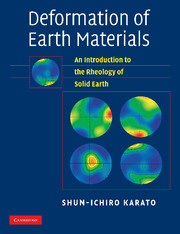Book contents
- Frontmatter
- Contents
- Preface
- Part I General background
- Part II Materials science of deformation
- 4 Elasticity
- 5 Crystalline defects
- 6 Experimental techniques for study of plastic deformation
- 7 Brittle deformation, brittle–plastic and brittle–ductile transition
- 8 Diffusion and diffusional creep
- 9 Dislocation creep
- 10 Effects of pressure and water
- 11 Physical mechanisms of seismic wave attenuation
- 12 Deformation of multi-phase materials
- 13 Grain size
- 14 Lattice-preferred orientation
- 15 Effects of phase transformations
- 16 Stability and localization of deformation
- Part III Geological and geophysical applications
- References
- Materials index
- Subject index
- Plate section
14 - Lattice-preferred orientation
Published online by Cambridge University Press: 05 June 2012
- Frontmatter
- Contents
- Preface
- Part I General background
- Part II Materials science of deformation
- 4 Elasticity
- 5 Crystalline defects
- 6 Experimental techniques for study of plastic deformation
- 7 Brittle deformation, brittle–plastic and brittle–ductile transition
- 8 Diffusion and diffusional creep
- 9 Dislocation creep
- 10 Effects of pressure and water
- 11 Physical mechanisms of seismic wave attenuation
- 12 Deformation of multi-phase materials
- 13 Grain size
- 14 Lattice-preferred orientation
- 15 Effects of phase transformations
- 16 Stability and localization of deformation
- Part III Geological and geophysical applications
- References
- Materials index
- Subject index
- Plate section
Summary
Non-random distribution of crystallographic orientation, lattice-preferred orientation (LPO) (or crystallographic-preferred orientation: CPO), is one of the important microstructural characteristics of rocks. LPO in naturally deformed rocks can be measured in the laboratory or LPO in rocks deformed in Earth's interior can be inferred from seismic anisotropy. If the physical processes by which LPO is formed are understood, then one can use measured or seismologically inferred LPO to infer physical processes such as a flow pattern in Earth. This chapter provides a review of the various ways of representing LPO and the physical processes for the formation of LPO including deformation-induced LPO and crystallization- (or recrystallization-) induced LPO. LPO is controlled by both the microscopic physics of deformation or the nucleation–growth of crystals and the macroscopic geometry of field in which LPO develops (finite strain ellipsoid, stress, magnetic field, heat flow etc.). The relation between LPO and deformation geometry can change with physical (and chemical) conditions of deformation.
Key words Lattice-preferred orientation (LPO), Euler angles, orientation distribution function (ODF), pole figure, inverse pole figure, J-index, M-index, Schmid–Boas relation, Taylor–Bishop–Hill model, self-consistent model, dynamic recrystallization, fabric transition.
Introduction
Distribution of crystallographic orientation of grains in a polycrystalline material may be non-random. It can be measured on rock samples and it can also be inferred from geophysical observations of anisotropic properties such as seismic anisotropy (see Chapter 21). This non-random distribution of crystallographic axes is called lattice-preferred orientation (LPO) or crystallographic-preferred orientation (CPO) or simply fabric.
- Type
- Chapter
- Information
- Deformation of Earth MaterialsAn Introduction to the Rheology of Solid Earth, pp. 255 - 270Publisher: Cambridge University PressPrint publication year: 2008
- 2
- Cited by



